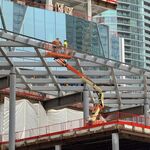Construction starts on new bus transit terminal in Markham
For immediate release
July 31, 2018
MARKHAM, ON — Today the Honourable Jane Philpott, Minister of Indigenous Services, Paul Calandra, Member of Provincial Parliament for Markham-Stouffville, Wayne Emmerson, Chairman and CEO of The Regional Municipality of York, and Frank Scarpitti, Chair of the Board of York Region Rapid Transit Corporation and Mayor of the City of Markham, joined together to mark the start of construction on a new bus transit terminal in the City of Markham.
Cornell Bus Terminal is being built at Highway 7 and Ninth Line within walking distance to Markham-Stouffville Hospital and the Cornell Community Centre & Library. It is an 11-bay bus terminal for YRT and Viva buses, with provisions for GO Transit and Durham Regional Transit in future. The terminal features a naturally-ventilated design with cyclist and pedestrian-friendly features.
“The Government of Canada recognizes how important affordable and efficient transit infrastructure is to growing the middle class and getting Canadians to work on time and back home quickly at the end of a long day,” said the Honourable Jane Philpott, Minister of Indigenous Services, on behalf of the Honourable François-Philippe Champagne, Minister of Infrastructure and Communities. “This is a very exciting time for York Region, and the Government of Canada is proud to support the Viva system. When the project is complete, the rapid transit system will help riders get around the Region faster while curbing greenhouse gas emissions.”
“Today’s announcement is good news for residents in Markham and I am happy to see that progress is being made on this project. Premier Ford’s new government is committed to expanding transit throughout this province. We will make sure that people can travel more efficiently along their daily commute because our economy depends on this,” said John Yakabuski, Minister of Transportation.
“Today’s groundbreaking demonstrates York Region’s ongoing commitment to build a world-class transit system,” said York Region Chairman and CEO Wayne Emmerson. “Transportation hubs, like the Cornell Terminal, further strengthen the efficiency of our network and create more sustainable options for our growing communities.”
“We are connecting communities and improving the overall transit network because transit is a driving economic force,” said Frank Scarpitti, Chair of the Board of York Region Rapid Transit Corporation and Mayor of the City of Markham. “By investing in new transit hubs like this, we will better serve our existing communities while attracting even more investment that benefits residents and businesses throughout Markham and York Region.”
On June 18, 2018, a $16.7 million contract was awarded to Orin Contractors Corporation for construction of the terminal. This new terminal will serve as a transit hub, connecting customers to destinations in York Region and neighbouring regions.
The total project cost is $36.8 million, with the Government of Canada contributing $10.4 million, the Province of Ontario providing $10.8 million and The Regional Municipality of York providing $15.6 million.
York Region Rapid Transit Corporation (YRRTC) is responsible for the planning, design and construction of the full vivaNext rapid transit network and related infrastructure to deliver on the transit priorities set out in the York Region Transportation Master Plan. YRRTC is a wholly-owned subsidiary and share capital corporation of The Regional Municipality of York. For more information, please visit
www.vivanext.com
The Regional Municipality of York consists of nine local cities and towns, and provides a variety of programs and services to 1.2 million residents and 51,000 businesses with 620,000 employees. More information about the Region’s key service areas is available at
york.ca/regionalservices
MARKHAM, ON — Today the Honourable Jane Philpott, Minister of Indigenous Services, Paul Calandra, Member of Provincial Parliament for Markham-Stouffville, Wayne Emmerson, Chairman and CEO of The Regional Municipality of York, and Frank Scarpitti, Chair of the Board of York Region Rapid Transit Corporation and Mayor of the City of Markham, joined together to mark the start of construction on a new bus transit terminal in the City of Markham.
Cornell Bus Terminal is being built at Highway 7 and Ninth Line within walking distance to Markham-Stouffville Hospital and the Cornell Community Centre & Library. It is an 11-bay bus terminal for YRT and Viva buses, with provisions for GO Transit and Durham Regional Transit in future. The terminal features a naturally-ventilated design with cyclist and pedestrian-friendly features.
“The Government of Canada recognizes how important affordable and efficient transit infrastructure is to growing the middle class and getting Canadians to work on time and back home quickly at the end of a long day,” said the Honourable Jane Philpott, Minister of Indigenous Services, on behalf of the Honourable François-Philippe Champagne, Minister of Infrastructure and Communities. “This is a very exciting time for York Region, and the Government of Canada is proud to support the Viva system. When the project is complete, the rapid transit system will help riders get around the Region faster while curbing greenhouse gas emissions.”
“Today’s announcement is good news for residents in Markham and I am happy to see that progress is being made on this project. Premier Ford’s new government is committed to expanding transit throughout this province. We will make sure that people can travel more efficiently along their daily commute because our economy depends on this,” said John Yakabuski, Minister of Transportation.
“Today’s groundbreaking demonstrates York Region’s ongoing commitment to build a world-class transit system,” said York Region Chairman and CEO Wayne Emmerson. “Transportation hubs, like the Cornell Terminal, further strengthen the efficiency of our network and create more sustainable options for our growing communities.”
“We are connecting communities and improving the overall transit network because transit is a driving economic force,” said Frank Scarpitti, Chair of the Board of York Region Rapid Transit Corporation and Mayor of the City of Markham. “By investing in new transit hubs like this, we will better serve our existing communities while attracting even more investment that benefits residents and businesses throughout Markham and York Region.”
On June 18, 2018, a $16.7 million contract was awarded to Orin Contractors Corporation for construction of the terminal. This new terminal will serve as a transit hub, connecting customers to destinations in York Region and neighbouring regions.
The total project cost is $36.8 million, with the Government of Canada contributing $10.4 million, the Province of Ontario providing $10.8 million and The Regional Municipality of York providing $15.6 million.
York Region Rapid Transit Corporation (YRRTC) is responsible for the planning, design and construction of the full vivaNext rapid transit network and related infrastructure to deliver on the transit priorities set out in the York Region Transportation Master Plan. YRRTC is a wholly-owned subsidiary and share capital corporation of The Regional Municipality of York. For more information, please visit
www.vivanext.com
The Regional Municipality of York consists of nine local cities and towns, and provides a variety of programs and services to 1.2 million residents and 51,000 businesses with 620,000 employees. More information about the Region’s key service areas is available at
york.ca/regionalservices





/arc-anglerfish-tgam-prod-tgam.s3.amazonaws.com/public/EZGHGWIAIJCFTHLDZ42NM7DXTA)

